This year, October is a big month for skywatchers: Excitement is largely centered on the “ring of fire” solar eclipse in the middle of the month, but there’s also plenty of activity with the moon, stars, and other planets to look forward to. These are a few of the major solar events to put on your calendar.
Annular solar eclipse (October 14)
The highlight this month is the “ring of fire” solar eclipse, which will take place on Oct. 14 and track across much of the western U.S.—a 152-mile-wide path that is home to approximately 6.6 million people.
Unlike in a total eclipse, the moon won’t fully cover the sun, but the alignment will allow a narrow ring of light to shine out from behind, creating a so-called “ring of fire.” The closer you are to the annular path, the larger the diameter of the sun will be blocked by the moon.
Annularity will begin at 9:13 a.m. PT near Eugene, Ore. on Saturday, Oct. 14, and work its way southeast through Nevada, Utah, New Mexico, and Texas (as well as small portions of California, Colorado, and Arizona) with an end at 12:03 p.m. CT. The eclipse may be visible for up to five minutes on the path. Those outside of these areas will still get a partial eclipse.
If you haven’t already planned a viewing, we’ve got a handful of recommendations for cool places to see the eclipse. And make sure you’re prepared to safely view it.
Orionid meteor shower peak (October 21–22)
The Orionid meteors originate with Halley’s Comet and show up in October every year in the Northern Hemisphere. (Halley’s Comet is also responsible for the Eta Aquariids in May.) The Orionid meteor shower is active Sept. 26–Oct. 21 but is expected to peak on Oct. 21–22. With ideal conditions, you may see as many as 10–20 meteors per hour.
While the shower may be visible beginning around 11:30 p.m. on Saturday, Oct. 21, the best viewing time is early in the morning (between 2 a.m. and 4 a.m. locally) in the southern sky on Oct. 22.
Full hunter’s moon (October 28)
After the nearly dark new moon that lines up perfectly with the mid-month annular solar eclipse, we’ve got a hunter’s moon to look forward to right before Halloween. Also called a sanguine or blood moon—and carrying a variety of names given by Indigenous peoples—the October full moon this year lines up with a partial lunar eclipse that will be visible in parts of Africa, Asia, and Europe.
The actual full moon will take place at 4:24 p.m. ET on Oct. 28, but it will light up the night sky from sunset to sunrise the following morning.

Leave a Reply
You must be logged in to post a comment.